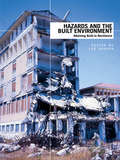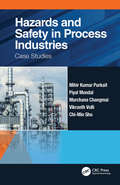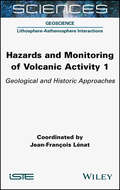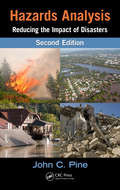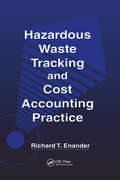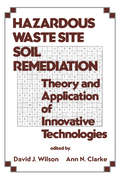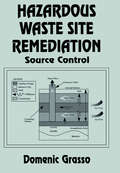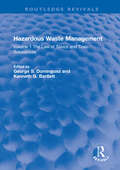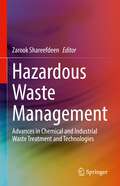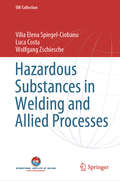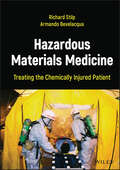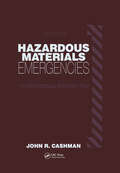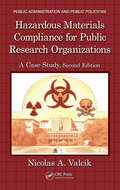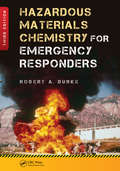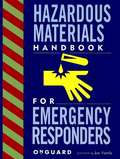- Table View
- List View
Hazards and the Built Environment: Attaining Built-in Resilience
by Lee BosherAs a specialist in disaster preparation, you have huge responsibilities: a failure to prepare for natural and human-induced disasters costs lives and money. When a natural or human-induced disaster hits a built-up area the amount of damage it does will depend largely on the extent to which the built assets in the area were developed to withstand it. To fail in this respect is therefore both ethically and financially negligent. What kinds of structural and non-structural alterations can be made to protect buildings from large-scale disasters? How can we reduce the threat of these disasters, as well as the damage they cause? Presenting seven guiding principles, drawn from a broad range of disciplines and approaches, this book tackles the difficult questions about what can be done to attain built-in resilience. With contributions from many renowned experts and upcoming researchers in the fields concerned, it comprehensively assesses the wide range of issues faced by practitioners. Whether you're studying construction management, researching hazard resilience issues or working on construction projects in hazardous regions, this book is for you.
Hazards and the Built Environment: Attaining Built-in Resilience
by Lee BosherAs a specialist in disaster preparation, you have huge responsibilities: a failure to prepare for natural and human-induced disasters costs lives and money. When a natural or human-induced disaster hits a built-up area the amount of damage it does will depend largely on the extent to which the built assets in the area were developed to withstand it. To fail in this respect is therefore both ethically and financially negligent. What kinds of structural and non-structural alterations can be made to protect buildings from large-scale disasters? How can we reduce the threat of these disasters, as well as the damage they cause? Presenting seven guiding principles, drawn from a broad range of disciplines and approaches, this book tackles the difficult questions about what can be done to attain built-in resilience. With contributions from many renowned experts and upcoming researchers in the fields concerned, it comprehensively assesses the wide range of issues faced by practitioners. Whether you're studying construction management, researching hazard resilience issues or working on construction projects in hazardous regions, this book is for you.
Hazards and Safety in Process Industries: Case Studies
by Mihir Kumar Purkait Piyal Mondal Murchana Changmai Vikranth Volli Chi-Min ShuSafety in process industries is of utmost necessity to ensure protection from hazards. The aim of this book is to elucidate the hazards and preventive measures for a few of such specific industrial processes. Starting with overview of the prevalent industrial accidents, types of hazards and safety provisions, the book contains nineteen chapters with each one of them consisting of a unique case study comprising of basic causes, results and discussion, and protective measures to be adopted to overcome such situation. Topics covered include caprolactam storage tank accident, fire explosion accident caused by static electricity, and human factors risk and management in process safety and so forth. Aimed at researchers, professionals, graduate students in Chemical Engineering, Safety Management, Risk Assessment, Chemical Process Safety, this book: Provides exhaustive coverage of industrial case studies on their hazards and safety issues in the process industry set-up. Includes quantitative discussion on new and existing technologies and methodologies. Explores high quality descriptive and quantified data for better visualization of each chapter. Gives detailed description on various industrial accidents, their related consequences and available safety/preventive measures. Discusses preventive measures taken by world class industries in their production plants.
Hazards and Safety in Process Industries: Case Studies
by Mihir Kumar Purkait Piyal Mondal Murchana Changmai Vikranth Volli Chi-Min ShuSafety in process industries is of utmost necessity to ensure protection from hazards. The aim of this book is to elucidate the hazards and preventive measures for a few of such specific industrial processes. Starting with overview of the prevalent industrial accidents, types of hazards and safety provisions, the book contains nineteen chapters with each one of them consisting of a unique case study comprising of basic causes, results and discussion, and protective measures to be adopted to overcome such situation. Topics covered include caprolactam storage tank accident, fire explosion accident caused by static electricity, and human factors risk and management in process safety and so forth. Aimed at researchers, professionals, graduate students in Chemical Engineering, Safety Management, Risk Assessment, Chemical Process Safety, this book: Provides exhaustive coverage of industrial case studies on their hazards and safety issues in the process industry set-up. Includes quantitative discussion on new and existing technologies and methodologies. Explores high quality descriptive and quantified data for better visualization of each chapter. Gives detailed description on various industrial accidents, their related consequences and available safety/preventive measures. Discusses preventive measures taken by world class industries in their production plants.
Hazards and Monitoring of Volcanic Activity: Geological and Historic Approaches
by Jean-François LénatThe impact of natural disasters has become an important and ever-growing preoccupation for modern societies. Volcanic eruptions are particularly feared due to their devastating local, regional or global effects. Relevant scientific expertise that aims to evaluate the hazards of volcanic activity and monitor and predict eruptions has progressively developed since the start of the 20th century. The further development of fundamental knowledge and technological advances over this period have allowed scientific capabilities in this field to evolve.Hazards and Monitoring of Volcanic Activity groups a number of available techniques and approaches to render them easily accessible to teachers, researchers and students.This volume is dedicated to geological and historical approaches. The assessment of hazards and monitoring strategies is based primarily on knowledge of a volcano&’s past behavior or that of similar volcanoes. The book presents the different types of volcanic hazards and various approaches to their mapping before providing a history of monitoring techniques
Hazards and Monitoring of Volcanic Activity: Geological and Historic Approaches
by Jean-François LénatThe impact of natural disasters has become an important and ever-growing preoccupation for modern societies. Volcanic eruptions are particularly feared due to their devastating local, regional or global effects. Relevant scientific expertise that aims to evaluate the hazards of volcanic activity and monitor and predict eruptions has progressively developed since the start of the 20th century. The further development of fundamental knowledge and technological advances over this period have allowed scientific capabilities in this field to evolve.Hazards and Monitoring of Volcanic Activity groups a number of available techniques and approaches to render them easily accessible to teachers, researchers and students.This volume is dedicated to geological and historical approaches. The assessment of hazards and monitoring strategies is based primarily on knowledge of a volcano&’s past behavior or that of similar volcanoes. The book presents the different types of volcanic hazards and various approaches to their mapping before providing a history of monitoring techniques
Hazards Analysis: Reducing the Impact of Disasters, Second Edition
by John C. Pine Rakesh K. GuptaThe impacts of natural and man-made disasters have increased exponentially over the past few decades. Moreover, with our global interconnectedness and the growing scale of disasters, today's catastrophic disasters can have regional, national, and even global economic consequences.Following in the tradition of the successful first edition, Hazards A
Hazardous Waste Tracking and Cost Accounting Practice
by Richard T. EnanderEnvironmental challenges have never been greater than today. There is the need for the utmost accuracy in the efforts to track the use, manufacture, processing, treatment, and disposal of toxic and hazardous materials. Legislation passed over the last twenty years has not only resulted in improved environmental quality, but has also created new levels of accountability for today's environmental professional. This book helps companies meet the ever-growing number of recordkeeping, reporting, and information-management demands. It assists the practicing professional who must keep facility records relating to the generation and managemnet of solid and hazardous waste. Specific guidance is given on the principles of waste material tracking by point of generation and fully loaded waste management cost accounting.
Hazardous Waste Tracking and Cost Accounting Practice
by Richard T. EnanderEnvironmental challenges have never been greater than today. There is the need for the utmost accuracy in the efforts to track the use, manufacture, processing, treatment, and disposal of toxic and hazardous materials. Legislation passed over the last twenty years has not only resulted in improved environmental quality, but has also created new levels of accountability for today's environmental professional. This book helps companies meet the ever-growing number of recordkeeping, reporting, and information-management demands. It assists the practicing professional who must keep facility records relating to the generation and managemnet of solid and hazardous waste. Specific guidance is given on the principles of waste material tracking by point of generation and fully loaded waste management cost accounting.
Hazardous Waste Site Soil Remediation: Theory and Application of Innovative Technologies
by David J. WilsonIntroduces the most up-to-date techniques for soil remediation, including chemical fixation/stabilization, soil vapor extraction, thermally enhanced vapor stripping, biodegradation, and air spargingwritten in a style accessible to nonspecialists. Desc4ibes the ex shu technique of thermal desorption of soil contaminants-a low-cost aftemative to incineration for the removal of organics.
Hazardous Waste Site Soil Remediation: Theory and Application of Innovative Technologies (Environmental Science And Pollution Ser. #6)
by David J. WilsonIntroduces the most up-to-date techniques for soil remediation, including chemical fixation/stabilization, soil vapor extraction, thermally enhanced vapor stripping, biodegradation, and air spargingwritten in a style accessible to nonspecialists. Desc4ibes the ex shu technique of thermal desorption of soil contaminants-a low-cost aftemative to incineration for the removal of organics.
Hazardous Waste Site Remediation
by Domenic GrassoHazardous Waste Site Remediation is an outstanding textbook that reviews specific treatment processes, as well as pertinent basic concepts in organic geochemistry, material balance mass transfer, thermodynamics, and kinetics. Following a quantitative approach to source control, the text covers regulations, materials handling, engineering principles, soil vapor extraction, chemical extraction and soil washing, solidification and stabilization, and chemical destruction. It also explores topics in bioremediation, thermal processes, risk assessment, and waste minimization. A solutions manual is available.
Hazardous Waste Site Remediation
by Domenic GrassoHazardous Waste Site Remediation is an outstanding textbook that reviews specific treatment processes, as well as pertinent basic concepts in organic geochemistry, material balance mass transfer, thermodynamics, and kinetics. Following a quantitative approach to source control, the text covers regulations, materials handling, engineering principles, soil vapor extraction, chemical extraction and soil washing, solidification and stabilization, and chemical destruction. It also explores topics in bioremediation, thermal processes, risk assessment, and waste minimization. A solutions manual is available.
Hazardous Waste Management: Volume 1 The Law of Toxics and Toxic Substances (Routledge Revivals)
by George S. Dominguez Kenneth G. BartlettFirst published in 1986: The Purpose of this book is to provide working managers with a comprehensive introduction to practical operational aspects of hazardous waste management and with an extremely important foundation in relevant laws, rules and regulations.
Hazardous Waste Management: Volume 1 The Law of Toxics and Toxic Substances (Routledge Revivals)
by George S. Dominguez Kenneth G. BartlettFirst published in 1986: The Purpose of this book is to provide working managers with a comprehensive introduction to practical operational aspects of hazardous waste management and with an extremely important foundation in relevant laws, rules and regulations.
Hazardous Waste Management: Advances in Chemical and Industrial Waste Treatment and Technologies
by Zarook ShareefdeenThis book provides readers with the most current knowledge on hazardous waste management practices. It addresses the rapidly changing advances in waste stream characterization and the discovery of new chemicals – which have led to new hazardous wastes, technological innovation, stringent environmental regulations, changes in transport and dispersion modelling of hazardous pollutants, and new waste management techniques. Hazardous Waste Management: Advances in Chemical and Industrial Waste Treatment and Technologies is an invaluable reference for waste management and treatment professionals, chemical engineers and technicians, medical professionals, and environmental regulators, as well as students taking courses on hazardous waste management, environmental engineering, and environmental science.
Hazardous Substances in Welding and Allied Processes (IIW Collection)
by Vilia Elena Spiegel-Ciobanu Luca Costa Wolfgang ZschiescheThis book provides information on the generation and the effects of hazardous substances that are produced during welding and allied processes. These processes are thermal cutting, thermal spraying, soldering and brazing. The book offers guidance on the determination of hazardous substances and it simplifies assessment of the hazard due to hazardous substances. In addition, the book explains tests in order to understand the concentration and intensity of key hazardous substances. Last but not least, the book suggests several possibilities of avoiding the risk to worker’s health as a result of exposing them to these substances.
Hazardous Materials Medicine: Treating the Chemically Injured Patient
by Richard Stilp Armando BevelacquaHazardous Materials Medicine Complete background on chemical exposures that create illnesses, including assessment, diagnosis, and treatment protocols Written on a level that can be understood by field practitioners and/or first responders, Hazardous Materials Medicine: Treating the Chemically Injured Patient provides an in-depth understanding of how to diagnose and treat toxic chemical exposures in a prehospital or emergency department setting. The protocols used in this book conform to the guidelines set forth in the NFPA 470 standard, and the medical guidance developed by FEMA for Type I, II & III Deployable Hazmat Response Teams. The hazardous materials medical protocols in this book have been fully vetted by three poison control toxicologists, multiple emergency physicians, and paramedics. Hazardous Materials Medicine: Treating the Chemically Injured Patient covers sample topics such as: Scene assessment, to help determine the cause of the exposure, and exposure assessment, to determine what physiologic systems are affected Toxic syndromes/toxidromes to appropriately treat the exposed patient, including corrosive and irritant, asphyxiant, cholinergic, and hydrocarbon and derivative toxidromes Science behind a chemical exposure, to allow for a complete understanding of both the chemistry and physiology of what is occurring because of the exposure Interfacing between the on-scene response team and the hospital, to ensure consistency and continuity of care from the field into the hospital Enabling public safety and health professionals to administer effective care while retaining their own personal safety, Hazardous Materials Medicine: Treating the Chemically Injured Patient is a must-have resource for emergency medical technicians, paramedics, hazmat technicians, and emergency physicians and nurses working in high-risk field situations with chemically injured patients.
Hazardous Materials Medicine: Treating the Chemically Injured Patient
by Richard Stilp Armando BevelacquaHazardous Materials Medicine Complete background on chemical exposures that create illnesses, including assessment, diagnosis, and treatment protocols Written on a level that can be understood by field practitioners and/or first responders, Hazardous Materials Medicine: Treating the Chemically Injured Patient provides an in-depth understanding of how to diagnose and treat toxic chemical exposures in a prehospital or emergency department setting. The protocols used in this book conform to the guidelines set forth in the NFPA 470 standard, and the medical guidance developed by FEMA for Type I, II & III Deployable Hazmat Response Teams. The hazardous materials medical protocols in this book have been fully vetted by three poison control toxicologists, multiple emergency physicians, and paramedics. Hazardous Materials Medicine: Treating the Chemically Injured Patient covers sample topics such as: Scene assessment, to help determine the cause of the exposure, and exposure assessment, to determine what physiologic systems are affected Toxic syndromes/toxidromes to appropriately treat the exposed patient, including corrosive and irritant, asphyxiant, cholinergic, and hydrocarbon and derivative toxidromes Science behind a chemical exposure, to allow for a complete understanding of both the chemistry and physiology of what is occurring because of the exposure Interfacing between the on-scene response team and the hospital, to ensure consistency and continuity of care from the field into the hospital Enabling public safety and health professionals to administer effective care while retaining their own personal safety, Hazardous Materials Medicine: Treating the Chemically Injured Patient is a must-have resource for emergency medical technicians, paramedics, hazmat technicians, and emergency physicians and nurses working in high-risk field situations with chemically injured patients.
Hazardous Materials Emergencies: The Professional Response Team
by John R. CashmanThis book is mostly structured around first-person interviews with nationally and locally recognized experts who have been in hazardous materials response for a number of years. To aid networking, the addresses and telephone numbers of all persons interviewed are listed at the end of each interview. The central narrative theme of the book has been to detail the actual methods, procedures, techniques, tactics, and "lessons learned" of specific hazardous materials response teams (HMRT) drawn from a number of different categories. The object is to have readers find a ready source to provide knowledge of what a teamed, trained, and equipped HMRT uses for methods, tactics, procedures, tools, vehicles, instruments, equipment, strategies, leak/fire/spill control, prevention, remedial actions, decision making, incidents, containment, or hazards. This book answers many questions for emergency responders that they may need to know tostay alive.
Hazardous Materials Emergencies: The Professional Response Team
by John R. CashmanThis book is mostly structured around first-person interviews with nationally and locally recognized experts who have been in hazardous materials response for a number of years. To aid networking, the addresses and telephone numbers of all persons interviewed are listed at the end of each interview. The central narrative theme of the book has been to detail the actual methods, procedures, techniques, tactics, and "lessons learned" of specific hazardous materials response teams (HMRT) drawn from a number of different categories. The object is to have readers find a ready source to provide knowledge of what a teamed, trained, and equipped HMRT uses for methods, tactics, procedures, tools, vehicles, instruments, equipment, strategies, leak/fire/spill control, prevention, remedial actions, decision making, incidents, containment, or hazards. This book answers many questions for emergency responders that they may need to know tostay alive.
Hazardous Materials Compliance for Public Research Organizations: A Case Study, Second Edition
by Nicolas A. ValcikCompletely revised and updated, Hazardous Materials Compliance for Public Research Organizations: A Case Study, Second Edition presents a case study of one university’s policies and practices with regard to the procurement, use, storage and disposal of HAZMAT in the context of a changing internal structure and regulatory environment. The author’s presentation is no-holds-barred, using interviews, archival documentation, and unobtrusive observations as a participant where the research institution was at times noncompliant with the new federal guidelines. See What’s New in the Second Edition: Incorporates issues with all types of hazardous materials instead of just focusing on biological HAZMAT Updated information on current regulations on HAZMAT in relation to universities and research centers Follow-up on the case study university, disclosing the university’s progress in resolving the security and safety shortcomings By implementing key improvements in safety and security, the universities can also more easily obtain research grant money and satisfy both state and federal safety requirements. This book includes recommendations to improve safety while using and storing biotoxins, chemical, radioactive material, and industrial waste, and to improve overall security at the university. It also highlights improvements that can make the environment a safer and more secure location to perform biological research.
Hazardous Materials Chemistry for Emergency Responders
by Robert BurkeThe third edition of a bestseller, Hazardous Materials Chemistry for Emergency Responders continues to provide the fundamentals of "street chemistry" required by emergency response personnel. Emergency response and hazmat expert Robert Burke takes the basics of chemistry appropriate for response personnel and puts it into understandable terms. The
Hazardous Materials: Handbook for Emergency Responders (Industrial Health And Safety Ser.)
by OnGUARDHazardous Materials Handbook for Emergency Responders breaks down the hazards and response priorities according to the nine classes of hazardous chemicals defined by the U.N. and the U.S. Department of Transportation. Designed to prepare HazMat professionals for all three levels of response, as defined by OSHA, the Handbook: Offers the most complete and current coverage of control and mitigation techniques for chemical emergencies. Provides extensive treatment of transportation and storage vessels. Helps users comply with all relevant government regulations and standards, including OSHA and NFPA training requirements.
Hazardous Materials: Handbook for Emergency Responders
by OnGUARDHazardous Materials Handbook for Emergency Responders breaks down the hazards and response priorities according to the nine classes of hazardous chemicals defined by the U.N. and the U.S. Department of Transportation. Designed to prepare HazMat professionals for all three levels of response, as defined by OSHA, the Handbook: Offers the most complete and current coverage of control and mitigation techniques for chemical emergencies. Provides extensive treatment of transportation and storage vessels. Helps users comply with all relevant government regulations and standards, including OSHA and NFPA training requirements.
